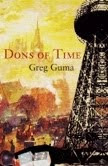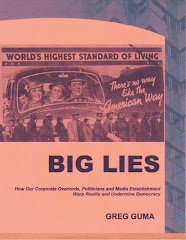During the Vermont International Film Festival last year, I was talking
in the hall with Nora Jacobson, producer of The
Vermont Movie, a six-part collaborative documentary that will be released
this fall and screened in theaters across the state.
Given the growth of social media and desire of many festival-goers to
share their reactions, I suggested that such gatherings could be more
interactive. At that moment I was filing reviews with VTDigger.org, but felt that
others attending might have something to add if given an accessible, real time
outlet.
Seven months later the White River Indie Film Festival (WRIF) decided
to use twitter and launch a blog. Asked over from Burlington I
became the “official” blogger for the weekend. Here’s some of what I saw.
Welcome to Cartoon College
Based on audience reactions, the opening night feature hit many of the
right notes. A full house at the Tupelo Music Hall frequently erupted with
laughter during a screening of Cartoon
College, which follows several students from admission to completion at
White River’s Center for Cartoon Studies.
At times it was like watching an offbeat version of Fame – the film, not the TV show.
You know the plot, several talented, very different students struggle to make
the grade; some do, others not so much. But these artists (with one exception)
are not obsessed with becoming the next big thing. Their goals and interests
are far more personal. For example, one develops stories about menstruation,
while another uses his art to understand life as a Mormon and his childhood
abuse by a brother.
Despite the serious life questions that drive many students, the film
is bright and energetic, with an engaging score, and sometimes breaks out of
traditional documentary style with montage sequences that show the artists at
work. Another effective moment uses jump cuts to telegraph the time and
frustration involved in collaborative production meetings. Although Cartoon College doesn’t have all
the quirkiness of its characters it explores with considerable sensitivity what
drives both students and their teachers to create.
Life as a cartoon artist clearly is not for everyone. It’s “more a
calling than a career,” says a teacher. Another describes it as “insanely labor
intensive but not insanely expensive.” Beyond that, it is one of the few jobs
where having a unique viewpoint can give you an edge. Of course, talent is also
a factor. But as the film shows, even someone with limited ability can find
much satisfaction in the process, along with a supportive community of kindred
spirits.
There were a few lingering questions. For example, how have local
residents responded to the evolution of an artistic enclave in their midst? And
since the town has been used as a setting for quite a few projects, just how do
the students see it?
What’s in a Name?
For some people using the term transmedia to describe what’s happening
in media today isn’t necessary. As Liz Canner noted at the opening workshop on Saturday,
what used to be “new media is now old media,” and it keeps happening. Yet some
projects use transmedia techniques to bring a new, interactive and immersion
element into the picture.
 |
| Local Filmmakers at the brunch |
“Transmedia is a cloud,” she added. “The innovation I see is in
combining the film and game worlds.” The projects are cinematic, but the form
can be almost anything. Crean described one radical project, a “heist” in which
the viewer becomes an actor in a 15-minute film and actually robs a bank.
“The content was commenting on consumerism, but they were reframing the
film experience,” she said, comparing it to The
Game, a Michael Douglas film. “You start to question the whole world around
you.”
According to Canner, “The difficulty is still to get an audience.”
Since the narrative of a transmedia project often proceeds via various
platforms, the challenge is that, if they’re only available online, it’s hard
to build an audience.
The promise of a democratized media has been partially realized, but
getting reviews remains a challenge, she said. On the other hand, an advantage
is that your work can have a longer life.
Hands on: Talking with Iraq
Using ideas from Crean’s Shape of Change project, festival-goers looked
at new ways to communicate with people in Iraq. After breaking into small
discussion groups, the goal was for each person to describe an artifact,
object or thing that symbolizes home — what the object has seen, any random
memories associated with it, or a story the object could tell.
A series of questions prompted others to write about the objects. For
example, if it was a door, a question might be, “What would you do if the door
to your house was suddenly gone?” or “What is the strangest thing you think the
front door to your house has seen?” A writing prompt might be, “The last time I
walked out this door I thought...”
The exchanges generated at iWRIF will be added to the
shapeofchange.com website, an online archive of opinions compiled across Iraq
and the US since 2008. To learn more about this project, check out Melanie’s Social Book.
Expanding the Documentary
Playbook
Laura Kissel’s project, Cotton
Road, goes behind the scenes in the production of cotton clothing though
film and the Internet. It also poses provocative questions about the short cuts
used these days and the negative impacts in a globalized process, as well as
providing interactive maps and visualizing the consequences.
The traditional documentary tends to be confrontational, sometimes even
“in your face.” As a result, people who make them are frequently accused of
preaching to the converted. Transmedia documentaries tend to use a different
approach, often focusing on small places, designing intentional encounters,
stressing collaboration and an open-ended process, and inviting viewers to play
an active role.
In response to this workshop editor Jeff Good wrote, “I found the Cotton Road and LunchLoveCommunity
projects to be interesting examples of combining media (short-form documentary
film, Web, mapping). But I wasn’t persuaded that they represent a revolution in
storytelling; they looked a lot like the kind of multi-platform journalism
that’s been going on for years on the websites of “legacy media,” i.e.
newspapers.
“With that in mind, I found it interesting that the scholars and
directors fell silent when asked if they had tried to intersect their efforts
with newspapers (and their websites), which still reach a lot of people and
might provide a powerful outlet for the kind of good work shown today. (I work
at one of those newspapers, so maybe I’m biased.)”
On Screen: Chasing Ice and For
Ellen
After the workshops three feature
films were shown at the Tupelo, while Peter Watkins’ prophetic 1971 dystopian fantasy,
Punishment Park, was screened nearby
at the Main Street Museum. I attended the screening Chasing Ice, an award-winning documentary, and For Ellen, a touching drama starring Paul Dano.
If you can sit through Jeff
Orlowski’s study of the world’s rapidly shrinking glaciers and the extraordinary
work of National Geographic photographer James Balog without becoming even more
concerned about climate change, you’re asleep or in denial. It’s an
exceptionally beautiful movie. But Balog’s use of time-lapse cameras to capture
the process also makes an incontrovertible case, while his determination in the
face of health issues sometimes borders on the obsessive. Still, that may be
what it may take to convince enough people there’s no time to lose.
Dano’s character in So Yong Kim’s
drama is also a bit obsessed – with his career as a rock star, but even more
with his estrangement from his young daughter. Faced with divorce papers he negotiates
a touching meeting and struggles with his life choices. Shot by Upper Valley
cinematographer Reed Morano it’s a small, intense drama that gives the actors,
especially Dano, plenty of space, and effectively employs close ups and
one-shot scenes to increase the emotional impact.
Other films screened during the
weekend included King Kelly, a satire
about an aspiring Internet star by Andrew Neel, and The House I Live in, Eugene Jarecki’s wrenching look at the US war
on drugs.
Local Filmmakers in the Spotlight
As the festival program guide
explained, the Upper Valley is an incubator for films. At the local filmmakers’
brunch on Sunday morning, we started off with three clever shorts by homegrown
talent: The Check Up, a cheeky comedy
by William Peters and Michael Mooney; Nico,
in which Ben Silberfarb follows a Chicago tap dancer; and Octopus Story, a charming animated short by Ken Leslie that uses
stop-motion to visualize a folk tale about an endangered indigenous community.
 |
| Dennis Mueller and Michael Fisher |
The morning ended with two works about the power and complexity of the
human mind: a segment from Darwin’s Extra
Sense by Wendy Conquest, Bob Drake and Dan Rockmore; and Out of the Den, a look at the life of
bears and a man who has spent more than a decade with them, produced by a
Dartmouth documentary class.
Post-Modern Challenges in the Transmedia Age
Despite the considerable promise
of new transmedia forms there are some pitfalls, including the nature of the
dominant media environment.
In the so-called “modern era,”
things basically made sense. Despite any setbacks, technical dangers or mad dictators
most people believed in the possibility of a better future, changing the world
that was changing us. But now we live in a “post-modern” world, and although
it’s not a totally negative place, it does emphasize uncertainty, spectacle,
and even the chaotic.
Self-conscious and often
self-contradictory, post-modernists tend to believe that truth is merely a
perspective and nothing should be taken that seriously. The characteristic
expression is irony, emphasizing the doubleness in whatever is being expressed.
A favorite grammatical device is quotation marks, reinforcing the idea that the
words don’t mean what they seem. This expresses the defensive cultural logic of
late-capitalism, and can play well into the schemes of media and political
demagogues.
Faced with machines that have
made life more complex, a vast amount of information – much of it unsettling,
and an overwhelming variety of “choices,” it’s hardly surprising that people,
especially the young, aren’t impressed with much of anything. Their favorite
books often revel in this sensibility and abandon the grand narrative approach
once standard in novels. Although most movies still rely on the old linear formula
– the hero confronting obstacles to reach an obvious goal – few people really
believe in that. Real life is so much more ambiguous and complex.
The central institutions of
post-modern civilization are, of course, the electronic media. Most advertising
suggests that appearances are what matter, while the shows wedged between them
reinforce ironic distance, often winking at us that it’s all a put-on. And the
news? Plenty of facts. But enduring truth? That’s the last thing we expect
anymore.
Meanwhile, despite all its
benefits, the “blogosphere” also accelerates social fragmentation. Many blogs
and Websites attract only like-minded people, creating a self-segregated news
and information environment that serves the interests of extremists. Truth and
facts are becoming debatable notions. This makes it more difficult for people
to reach agreement or even have a civil discussion, and easier for opportunists
to ignore or distort reality for the sake of pushing initiatives based on
convenience or special interests.
That said, the news is not all
bad. In fact, along with skepticism comes a re-awakened concern about the human
spiritual condition and the planet’s health. It has also become easier to
create or manipulate photos, video and music; in effect, to become an
independent content producer.
According to Henry Jenkins, one of the earliest academic thinkers to notice the potential of transmedia, new tools allow people to “write over”
the dominant media culture, to remix, remold, amend and extend it – and then
re-circulate a new creation, possibly even crossing back into the “mainstream”
media.
Since this type of storytelling requires coordination across media,
Jenkins believes that it works best either for independent projects where one
artist shapes the story across all the media involved, or those where strong
collaboration is encouraged across divisions of the same company.
One clear hallmark of transmedia is a marriage of narrative and new
technology. “Passive viewing and active viewing are changing,” explains Genna
Terranova, director of programming for the Tribeca film festival in
New York. “You see it in our own cultural habits, where you watch TV and have a
second screen on Twitter or are interacting on Facebook. Now you’re starting to
see independent projects harnessing all these tools and creating stories that
live on multiple platforms.”
At this year's film festival in White River, the promise of this new media era was on full and vivid display.
At this year's film festival in White River, the promise of this new media era was on full and vivid display.












































